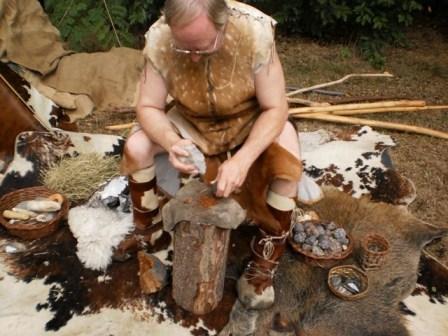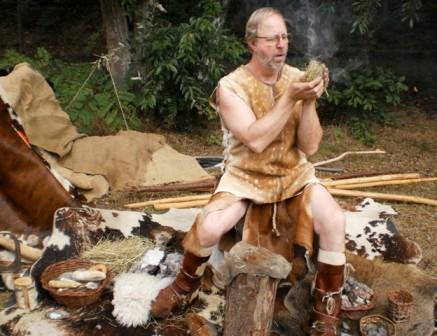 Flint is a hard (mainly) brown or gray stone of which our ancestors also made arrowheads etc. . It is the hardest stone type that you can find in the Netherlands. By that hardness it has also glassy, sharp (clamshell shaped) edges on fracture surfaces. It is well fissile, and harder than steel! By striking flint against iron or pyrite you can get sparks. For this purpose, flint was used in Medieval firearms! A spark is an iron particle that spontaneously oxidizes in air and gives a lot of heat. This can ignite tinder.
Flint is a hard (mainly) brown or gray stone of which our ancestors also made arrowheads etc. . It is the hardest stone type that you can find in the Netherlands. By that hardness it has also glassy, sharp (clamshell shaped) edges on fracture surfaces. It is well fissile, and harder than steel! By striking flint against iron or pyrite you can get sparks. For this purpose, flint was used in Medieval firearms! A spark is an iron particle that spontaneously oxidizes in air and gives a lot of heat. This can ignite tinder.
Iron can be replaced by marcasite (stone) (also called white iron pyrite or iron sulfide), these sparks would even glow longer.
The sulfur in marcasite tuber reacts with oxygen. To preserve the quality of the tuber to make sparks it would therefore be useful to seal him as many as possible of air (eg. with resin) and just leave the used portion free.
During the day you do not see these little sparks. But you can hear if the stroke is good, and you smell sulfur.
 Do not use sharp shards, but rounded stones: with more interface you get more sparks. Turn them close enough to fine, dry and fluffy tinder. Blow the glowing coal, wrap it in flammable, dry material and blow the fire (possibly with a blowpipe).
Do not use sharp shards, but rounded stones: with more interface you get more sparks. Turn them close enough to fine, dry and fluffy tinder. Blow the glowing coal, wrap it in flammable, dry material and blow the fire (possibly with a blowpipe).
Pyrite is composed of iron and sulfur, gold colored, is harder than gold (Fools Gold) and loses its luster when exposed to air.
(Flint on flint provides only ’cold sparks’, this does not work.)
Flint is found as tuber in limestone or chalk. The in South Limburg Rijkhold mined stones were apparently traded from their flint mine over a large part of Germany (hundreds of kilometers) thousands of years ago. Our ancestors were apparently specialists. In some mines they dug through a layer of flint to the next for even better quality!
Finds in the Dordogne suggest that Neanderthals already knew that firewood ignites faster if you scatter grit of manganese dioxide over it. This soft, metallic and oxygen containing rock lowers the ignition temperature of 460 to 250 degrees.
